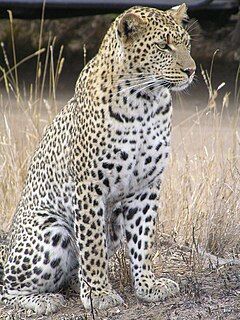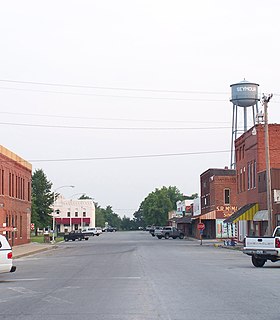
Penguins are a group of aquatic flightless birds. They live almost exclusively in the Southern Hemisphere, with only one species, the Galápagos penguin, found north of the equator. Highly adapted for life in the water, penguins have countershaded dark and white plumage and flippers for swimming. Most penguins feed on krill, fish, squid and other forms of sea life which they catch while swimming underwater. They spend roughly half of their lives on land and the other half in the sea.

Seymour Aubrey Papert was a South African-born American mathematician, computer scientist, and educator, who spent most of his career teaching and researching at MIT. He was one of the pioneers of artificial intelligence, and of the constructionist movement in education. He was co-inventor, with Wally Feurzeig and Cynthia Solomon, of the Logo programming language.

The leopard is one of the five extant species in the genus Panthera, a member of the Felidae. It occurs in a wide range in sub-Saharan Africa, in small parts of Western and Central Asia, a small part of European Russia, and on the Indian subcontinent to Southeast and East Asia. It is listed as Vulnerable on the IUCN Red List because leopard populations are threatened by habitat loss and fragmentation, and are declining in large parts of the global range. In Hong Kong, Singapore, South Korea, Jordan, Morocco, Togo, the United Arab Emirates, Uzbekistan, Lebanon, Mauritania, Kuwait, Syria, Libya, Tunisia and most likely in North Korea, Gambia, Laos, Lesotho, Tajikistan, Vietnam, and Israel, leopard populations have already been extirpated. Contemporary records suggest that the leopard occurs in only 25% of its historical global range.

O. R. Tambo International Airport is an international airport situated in Kempton Park, Gauteng, South Africa. It serves as the primary airport for domestic and international travel to/from South Africa and is Africa's busiest airport, with a capacity to handle up to 28 million passengers annually. The airport serves as the hub for South African Airways. The airport handled over 21 million passengers in 2017.

Seymour is a city in southeastern Webster County, Missouri, United States. The population was 1,921 at the 2010 census. It is part of the Springfield, Missouri Metropolitan Statistical Area.

A Bantustan was a territory that the National Party administration of South Africa set aside for black inhabitants of South Africa and South West Africa, as part of its policy of apartheid. The Government established ten Bantustans in South Africa, and ten in neighbouring South West Africa, for the purpose of concentrating the members of designated ethnic groups, thus making each of those territories ethnically homogeneous as the basis for creating autonomous nation states for South Africa's different black ethnic groups. Under the Bantu Homelands Citizenship Act of 1970, the Government stripped black South Africans of their citizenship, which deprived them of their few remaining political and civil rights in South Africa, and declared them to be citizens of these homelands.

Macadamia is a genus of four species of trees indigenous to Australia, and constituting part of the plant family Proteaceae. They are native to north eastern New South Wales and central and south eastern Queensland. Three species of the genus are commercially important for their fruit, the macadamia nut. Global production in 2015 was 160,000 tonnes. Other names include Queensland nut, bush nut, maroochi nut, bauple nut, and Hawaii nut. In Australian Aboriginal languages, the fruit is known by names such as bauple, gyndl, jindilli, and boombera. It was an important source of bushfood for the Aboriginal peoples who were the original inhabitants of the area.

The Hepialidae are a family of insects in the lepidopteran order. Moths of this family are often referred to as swift moths or ghost moths.

South African Astronomical Observatory (SAAO) is the national centre for optical and infrared astronomy in South Africa. It was established in 1972. The observatory is run by the National Research Foundation of South Africa. The facility's function is to conduct research in astronomy and astrophysics. The primary telescopes are located in Sutherland, which is 370 kilometres (230 mi) from Observatory, Cape Town, where the headquarters is located.

Dunsborough is a coastal town in the South West of Western Australia, 254 kilometres (158 mi) south of Perth on the shores of Geographe Bay.

Arthur Gardiner Butler F.L.S., F.Z.S. (1844–1925) was an English entomologist, arachnologist and ornithologist. He worked at the British Museum on the taxonomy of birds, insects, and spiders.
Cecidosidae is a little-known family of primitive monotrysian moths in the order Lepidoptera which have a piercing ovipositor used for laying eggs in plant tissue in which they induce galls, or they mine in bark. Nine species occur in southern Africa, five species in South America and Xanadoses nielseni was recently described from New Zealand. Some minute parasitoid wasps are known.
Paul Christopher Seymour is a former American football player. He played college football for the University of Michigan from 1969 to 1972 and was selected as a consensus first-team offensive tackle on the 1972 College Football All-America Team. He later played professional football in the National Football League (NFL) as a tight end for the Buffalo Bills from 1973 to 1978, catching 62 passes for 818 yards.
Robert Herbert Carcasson was an English entomologist who specialised in butterflies, but also authored two field guides to tropical fishes. He joined the Coryndon Museum, Nairobi, as senior entomologist in 1956. He then became its director, under the museum's new name of the Natural History Museum from 1961 to 1968. During this time he was awarded a PhD for his studies on African hawkmoths. From 1969 to 1971 he was Chief Curator of the Centennial Museum, Vancouver, Canada. In 1972 he travelled in Polynesia, Melanesia, Australia, Malaysia, Sri Lanka, Seychelles and East Africa for production of two field guides to coral reef fish of the Indo-Pacific region. From 1973 to 1979 he was Curator of Entomology at the Museum of British Columbia. He died of cancer. Somewhat a polymath, he was fluent in a number of languages, and produced the illustrations to a number of his works, culminating in hundreds of colour and line drawings of fishes for his reef fish field guides.

South Africa, officially the Republic of South Africa (RSA), is the southernmost country in Africa. With over 59 million people, it is the world's 24th-most populous nation and covers an area of 1,221,037 square kilometres. South Africa has three capital cities: executive Pretoria, judicial Bloemfontein and legislative Cape Town. The largest city is Johannesburg. About 80% of South Africans are of Black African ancestry, divided among a variety of ethnic groups speaking different African languages. The remaining population consists of Africa's largest communities of European, Asian, and multiracial ancestry.

Barrow Hill railway station is a former railway station in the village of Barrow Hill in northern Derbyshire, England.

Many populations of Lepidoptera migrate, sometimes long distances, to and from areas which are only suitable for part of the year. Lepidopterans migrate on all continents except Antarctica, including from or within subtropical and tropical areas. By migrating, these species can avoid unfavorable circumstances, including weather, food shortage, or over-population. In some lepidopteran species, all individuals migrate; in others, only some migrate.

Sada is a semi-rural settlement, situated 3 km away from Whittlesea, 30 km north of Seymour and 40 km south of Queenstown, Eastern Cape Province. The word Sada means "finally" or "at last" in isiXhosa because the first settlers struggled to find a place before they settled in the area in 1964.

Mary Seymour Conservation Park is a protected area in the Australian state of South Australia located in the south-east of the state in the gazetted locality of Bool Lagoon about 25 kilometres (16 mi) south-west of the town centre of Naracoorte.
The Egyptian Building is the home of University of Cape Town's Michaelis School of Fine Art on that school's campus on Orange Street in Cape Town, South Africa.















